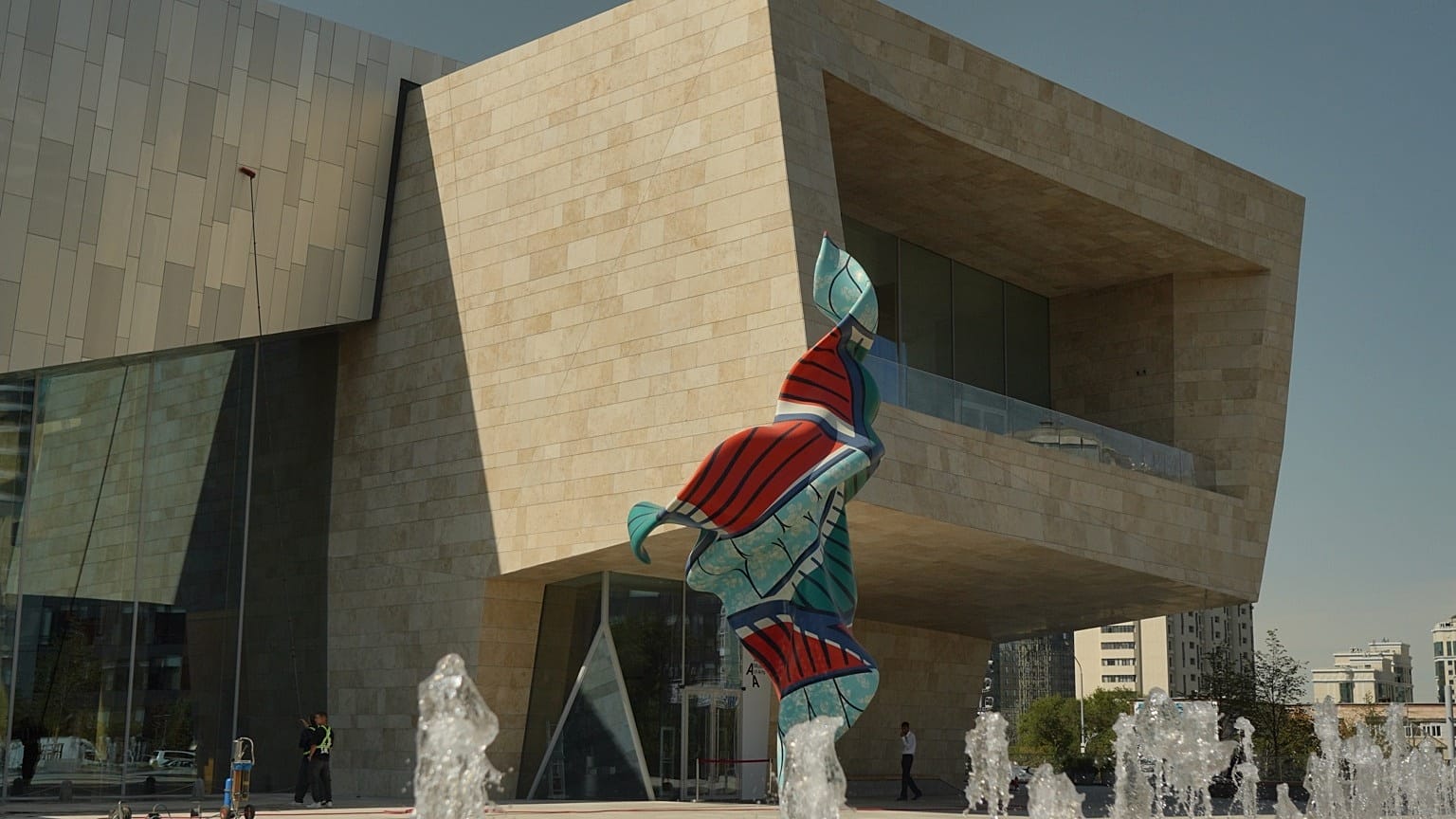Top Stories
Almaty Museum of Arts Unveils Bold New Space for Contemporary Art

The highly anticipated Almaty Museum of Arts has officially opened its doors in Kazakhstan’s cultural capital, marking a significant addition to the region’s artistic landscape. Founded by businessman and philanthropist Nurlan Smagulov, the museum features over 700 works from local and Central Asian artists, alongside pieces from renowned international creators. This new establishment aims to become a central hub for contemporary art in Central Asia, showcasing a diverse array of media and perspectives.
Nestled at the base of the Tian Shan mountains, the museum itself is a striking architectural achievement. Designed by British firm Chapman Taylor, the 10,060-square-meter complex, completed over three years, consists of two intersecting wings—one clad in Jura limestone and the other in aluminum. This design symbolizes the interplay between Almaty’s urban environment and its mountainous backdrop.
Outdoor Art and Initial Exhibitions
Visitors are greeted by large-scale outdoor installations that set the tone for their experience. Notable works include Spanish artist Jaume Plensa’s NADES (2023), a twelve-meter portrait of a young woman that invites contemplation amid the bustling city. Another significant piece, Yinka Shonibare‘s Wind Sculpture (TG) II (2022), features a vibrant aluminum scarf that reflects Central Asian traditions and cultural identity.
The museum launched with two inaugural exhibitions, starting with Qonaqtar, which translates to “Guests” in Kazakh. This exhibition focuses on the artistic expressions of the 1960s, celebrating nomadic culture and daily life. Highlights include Bahtiar Tabiyev’s Baursaks (1993) and Aisha Galimbayeva’s Shepherd’s Feast (1965). As visitors explore, they encounter deeper reflections on the complexities of Central Asia’s artistic heritage, particularly in the context of Soviet restrictions.
The centerpiece of this exhibition is Salikhitdin Aytbayev’s photograph On Virgin Soil. Lunchtime (1960s), which addresses the Soviet Virgin Lands campaign. Chief curator Inga Lāce noted the significance of migration during this period, emphasizing how it transformed the demographics of Kazakhstan.
Retrospective of Almagul Menlibayeva
Another highlight of the museum’s opening is the retrospective titled I Understand Everything, dedicated to multidisciplinary artist Almagul Menlibayeva. Known for her innovative blend of Eurasian myths and contemporary themes, Menlibayeva’s work challenges traditional narratives around identity and resilience. Her pieces have gained international acclaim, having been featured in exhibitions at major venues such as the Venice Biennale.
Menlibayeva expressed her excitement about the museum’s opening, describing it as a “temple of art” that provides a much-needed space for creative dialogue. The retrospective is curated by Gridthiya Gaweewong, Artistic Director of the Jim Thompson Art Center, and will unfold in two chapters. The first will focus on the Kazakh steppe and the Semipalatinsk nuclear test zone, culminating in the installation Kurchatov 22, named after the site central to the USSR’s nuclear weapons program.
The second chapter, set to open in February 2026, will explore Kazakhstan’s geopolitical landscape, addressing themes such as Stalin-era labor camps and women’s roles along the Silk Road.
The museum also features significant works by prominent international artists. Richard Serra‘s Junction (2011) envelops visitors in curving steel forms that redefine spatial perception. Additionally, Anselm Kiefer‘s installation Questi scritti, quando verranno bruciati, daranno finalmente un po’ di luce (2020–2021) combines oil, burnt books, and metal wire to evoke themes of destruction and renewal.
Looking ahead, the Almaty Museum of Arts plans to frequently rotate its collection and host solo exhibitions. With ongoing development of workshops, education programs, and a conservation lab, the museum aspires to become a vibrant nexus for art and dialogue in Central Asia, fostering a dynamic cultural exchange that resonates far beyond its walls.
-

 Top Stories1 month ago
Top Stories1 month agoTributes Surge for 9-Year-Old Leon Briody After Cancer Battle
-

 Entertainment2 months ago
Entertainment2 months agoAimee Osbourne Joins Family for Emotional Tribute to Ozzy
-

 Politics3 months ago
Politics3 months agoDanny Healy-Rae Considers Complaint After Altercation with Garda
-

 Top Stories2 months ago
Top Stories2 months agoIreland Enjoys Summer Heat as Hurricane Erin Approaches Atlantic
-

 World3 months ago
World3 months agoHawaii Commemorates 80 Years Since Hiroshima Bombing with Ceremony
-

 Top Stories3 months ago
Top Stories3 months agoFianna Fáil TDs Urgently Consider Maire Geoghegan-Quinn for Presidency
-

 World3 months ago
World3 months agoGaza Aid Distribution Tragedy: 20 Killed Amid Ongoing Violence
-

 World3 months ago
World3 months agoCouple Convicted of Murdering Two-Year-Old Grandson in Wales
-

 Top Stories4 weeks ago
Top Stories4 weeks agoNewcastle West Woman Patricia Foley Found Safe After Urgent Search
-

 Top Stories2 months ago
Top Stories2 months agoHike Donegal’s Errigal Mountain NOW for Unforgettable Summer Views
-

 Top Stories2 months ago
Top Stories2 months agoClimbing Errigal: A Must-Do Summer Adventure in Donegal
-

 World3 months ago
World3 months agoAristocrat Constance Marten and Partner Convicted of Infant Murder









